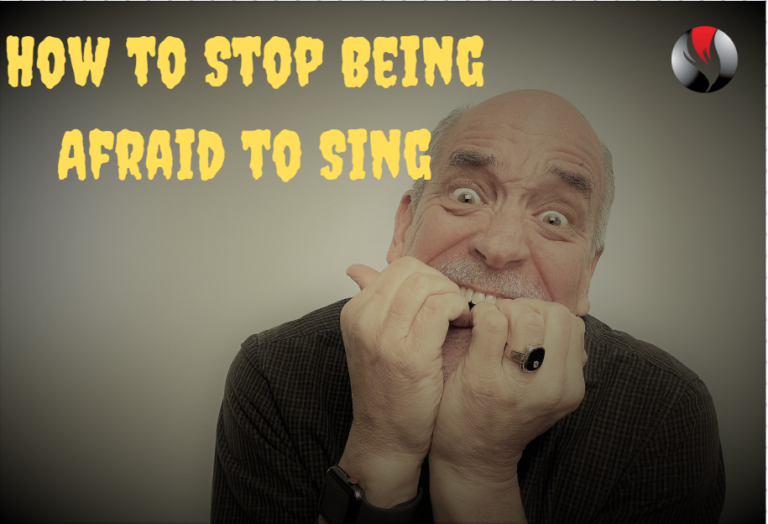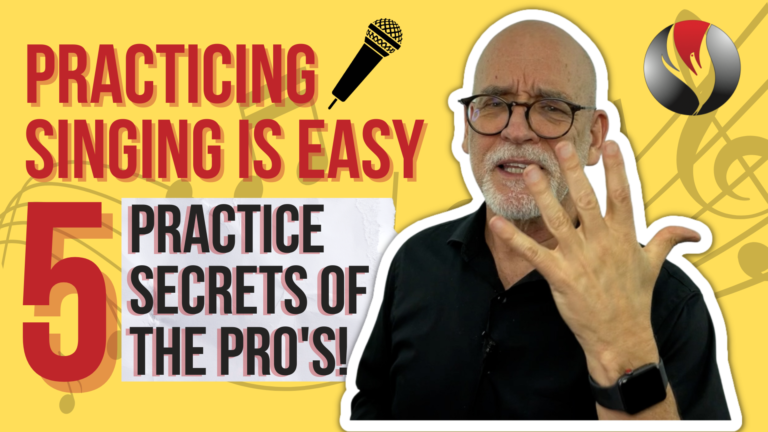Stuck at the top of your chest voice? Here are the 3 best vocal exercises for singers to sing higher.
Hi, I’m Chuck Gilmore, Founder of Power To Sing and the Second Nature Singing System.
As a young man I sang all the time. My high school madrigal group toured Europe. I sang in leading roles in the school musicals. But I couldn’t sing high notes. I was stuck at the first E above middle C. Anything past that and I had to yell (which sounded awful) or break into falsetto which had no power.
I thought I was at the top of my range. I thought I was born with vocal cords that only stretched so far and that I had reached my physical limits. In my mind, it was impossible to sing higher because that was a physical limitation I was born with.
What about you? Have you experienced the same thing in your voice?
My best friend could hit notes much higher than I could. We often sang together, harmonizing with the song. He took the high notes and I took the low ones.
He sang tenor, I sang bass. Also, he sang the roles in our musicals with higher notes. I got the roles with the lower notes.
Our school put on Rodgers and Hammerstein’s musical, Carousel. I wanted the leading role, but I discovered that Billy Bigalow sang a G4 in his soliloquy, My Boy Bill. And the song ended with a big climax note on the F4.
I didn’t audition for the part because I could not sing those notes. Furthermore, I didn’t even try for the part, because I knew my voice. I couldn’t do it.
Has that ever happened to you? Maybe not with a musical, but in a song you wanted to sing? Have you found yourself limited vocally?
It’s discouraging. After a major failure singing, I stopped singing solos. I went 25 years without singing another solo for an audience. It hurt emotionally. Especially when I went to see musicals. I longed to be on stage performing, but I knew I couldn’t sing the way those singers were singing.
Then I had a shocking experience. I attended a Seth Riggs workshop and did this vocal exercise.
This is my number one recommended exercise for every singer. Thanks to Seth Riggs, the exercise is now well known throughout the world.
Why is this exercise number one?
-
It helps keep the larynx down
-
It trains the vocal cords to adjust from chest voice, through the middle and into head voice and then back down to the chest voice
-
Furthermore, it requires breath support and naturally engages the diaphragm so you have enough air to complete the exercise
-
It allows the resonance to shift from the vocal cords, up into the head cavities without engaging the swallowing muscles that raise the larynx.
-
It’s also a great warmup for all singers of all ages and the 1 ½ scale exercises the full range of the voice.
The second best exercise for singers to increase their range is “gee”. When you first learn this exercise, it’s helpful to add a dumb or dopy sound to the gee.
You would never sing with a dumb sound, so once you’re able to do the exercise from chest voice through the middle and into head voice with a connected tone, discontinue the dumb sound.
Personally, this was the exercise that first enabled me to get out of my chest voice without yelling or breaking into falsetto. It was the exercise that enabled me to get into my mix and head voice with a word and not just bubble lips.
I remember doing the exercise as I was driving. I knew immediately I had done something I’d never done before in my life. It was awkward, and the feeling was new and uncertain, but it was the beginning of adding an octave to my range. It actually felt miraculous, wasn’t long before I could do this.
Why is this exercise number two?
-
The dumb sound activates muscles below the larynx to pull it downward and helps keep the larynx down as you sing high notes. That was a major problem for me because I always reached upward, straining to hit my highest notes. This exercise changed everything for me.
-
Gee can be done with the 5 tone, Octave Repeat and 1 ½ scales.
-
It’s a perfect exercise to use after bubble lips because it’s closer to actual singing with words.
-
It’s a great exercise to use in your songs. Substitute the lyrics with gee. Add the dumb sound if you struggle hitting the higher notes because the larynx is coming up. Gradually reduce the dumb sound until you can do it normally. Then return to the lyrics. Repeat this process until you can easily sing the words.
The third best exercise for singers to increase their range is “ney”. Often an exaggerated pharyngeal sound is added so the exercise sounds like this: [Demo with 5 tone]. This exercise works great to connect the tone through chest, middle and head voice. Like the gee with the dumb sound, discontinue the exaggerated sound once you are able to connect the tone.
Why is this exercise number three?
-
Ney helps connect the chest, middle and head voice with an even and consistent tone.
-
It’s an excellent exercise to strengthen and balance the tone. In other words, if the tone is too breathy or airy, it replaces the breathiness with a stronger tone. If there is too much chest voice, it thins the heaviness of chest voice so it’sd easier to sing higher.
-
As with the gee, you can use ney interchangeably with the lyrics of a song to help to reduce pulled chest or strengthen the tone on the higher notes, making it easier to sing the middle and head voice pitches.
-
Ney is a word, and without the exaggerated tone, is close to singing
Bubble lips, gee and ney are also excellent exercises for the teenage boy whose voice is changing and who’s having difficulty getting into his new man’s head voice.
These exercises can all be done with the 5 tone, octave repeat and 1 ½ scales illustrated above. The octave repeat can be slightly modified to work better with the bubble lips.
Finally, doing these exercises with the mental picture of reaching down, rather than up will make the high pitches feel easier. And don’t forget to use your low, diaphragmatic breath with each exercise.
Watch this video for help with breathing and breath control.
These exercises will help you sing higher notes faster and better. But you don’t want to stop there. You want to add exercises designed for your vocal type. This will speed up your results and help you master songs sooner.
To discover your vocal type click on this link here, or in the description below this video. Your vocal type will help you understand what your voice does as you sing high notes.
More importantly, you can then do vocal exercises to sing higher designed for your voice which will give you sustained and rapid results. Those familiar with Second Nature Singing will recognize that these are Designer Exercises found in Pillar One of the Second Nature Singing System.
Please take a moment and like this video, subscribe and click the bell to be notified when I post videos. You can also join me on Twitter, Facebook and Instagram @powertosing.
I’m Chuck Gilmore with Power to Sing. For you Singing Higher can be second nature.








Responses
Thanks Stephen!
Great video and text. Explaining the how and why of an exercise, greatly impacts the motivation to do the exercises. Well done Chuck (your never stuck) Gilmore ????
Thanks Pat!
Thank you for the revision information . Should do more. Will do more. Hope you have kept well.,